Have you heard that local SEO is only for walk-in businesses?
Or that software as a service companies should put ALL their efforts into national SEO since all their clients are online (and completely ignore their local SEO)?
Well, guess what?
Those aren’t true.
Just because no one will show up at your doorstep doesn’t mean your SaaS business can’t benefit from local search engine optimization.
But while local SaaS SEO can help, you might be wondering…
“Should I focus on my local SEO? Or is it a waste of time?”
Unfortunately, answering that is not as easy as saying yes or no – because every SaaS company has different needs.
That’s why in this article, we’re going to take an in-depth look into that question. And by the end of it, you’ll know:
And, of course, you’ll know whether or not you should work on your local SEO.
Let’s get started!
Before we dive into the deep stuff, let’s review the basics first.
What’s the difference between search engine optimization and local search engine optimization?
Goal: Rank your website for organic search keywords
Techniques: Content writing, link building, on-page and technical SEO
Target: Everyone on the internet interested in your product/service
Goal: Get to the top of Google’s map pack
Techniques: GMB profile optimization, citation building, gathering customer reviews
Target: People in a specific location (neighborhood, city, or state)
SEO, also known as national SEO, is the strategy used to rank organically on search results.
Gathering backlinks, writing a great piece of content, fixing on-page and technical issues – these are the steps you take to improve national SEO.
They’ll build up your domain rank and bring in organic traffic from all over the internet.
Local SEO, on the other hand, is the SEO strategy used to rank for local keywords.
Keywords with a location on them are local keywords. Terms like “Pizzeria in Orlando” or “Laptop repair near me” are local keywords.
The primary goal of local search engine optimization is to get to the top of Google’s map pack – making it super easy for people in your area to find your business.
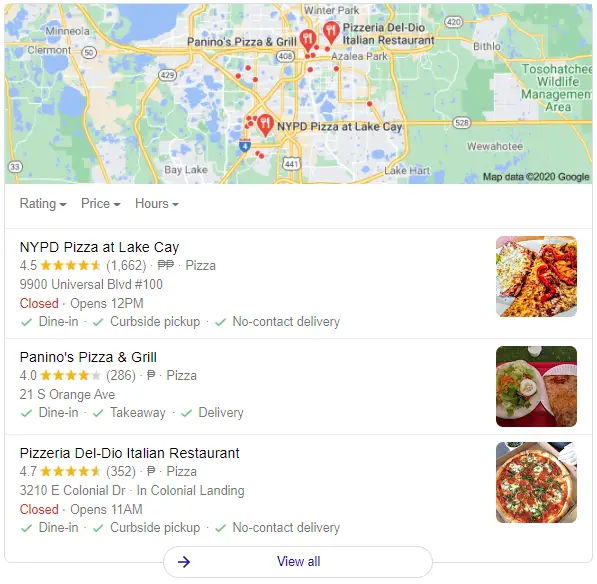
You can see why this will be great for a pizzeria or a repair shop…
…but a SaaS business???
Why should a software company – whose clients are 100% online – care about ranking their business on Google maps?
It’s not like anybody will search for “Best calendar software in Boston” or “CRM for small business in Atlanta.”
Nobody adds a location when they are searching for a SaaS company.
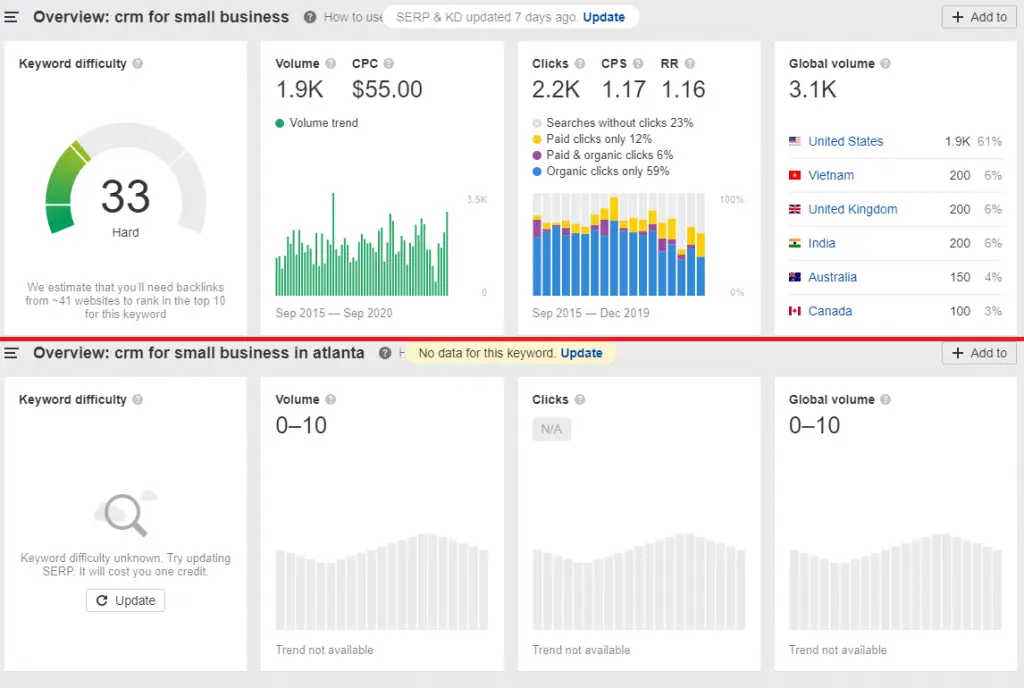
That’s why your gut reaction might be that local SEO is useless for a Saas company. After all, you want organic traffic from all over the place – not locals only.
But it’s not.
While it’s true that software as a service companies should focus on their national SEO first, local SEO is NOT worthless.
Here’s why:
Vincent Van Gogh once said, “Great things are done by a series of small things brought together.”
The Starry Night is the perfect manifestation of this. Van Gogh brought thousands of individual strokes together to create this magical painting.
Now you’re probably thinking…
What the heck does that have to do with SEO?!?
Well… successful SEO drives are a LOT like art pieces.
Thousands of small elements have to come together to create an SEO masterpiece.

And one of these small elements is local SEO.
As a SaaS company, creating an excellent content strategy or getting a link from a top site are the big wins – they always will be. But you should never underestimate the power of small wins.
So… how exactly does local SEO help?
Four ways:
Most people believe that national SEO and local SEO are entirely separate, which isn’t true.
While they have different goals, both national and local search engine optimization work hand-in-hand a lot more than people realize.
For example – link-building.
There are several methods you can use to bring more links to your site (check out our ultimate SaaS company SEO guide to learn a few).
One lesser-known way to do this is by getting citations, a local SEO strategy (you’ll learn how to do this in a bit).
Any text or image that hyperlinks to your website
Boosts domain rank and drives in organic traffic to website
Typically comes with context (from blog posts)
Anywhere your name, address, and number (NAP) appears online *doesn’t have to include link
Boosts rank in Google maps and drives in foot traffic
Typically comes without context (from business listings)
You can get your link out to a LOT of websites quickly with citation building.
Plus, these aren’t low-quality links either. Citations come from powerful websites like Yelp,
Yahoo, Bing, etc.
Are these the best links in the world?
No.
Links from citations aren’t as valuable as traditional links.
Nonetheless, they’re still coming from authoritative places pointing to your site – which is never a bad thing.
A good Google My Business profile is one of the BEST ways to build trust with potential clients (we’ll show you how to create one below).
In GMB, everybody can view your business name, office address, and telephone number – as well as see pictures of your office.
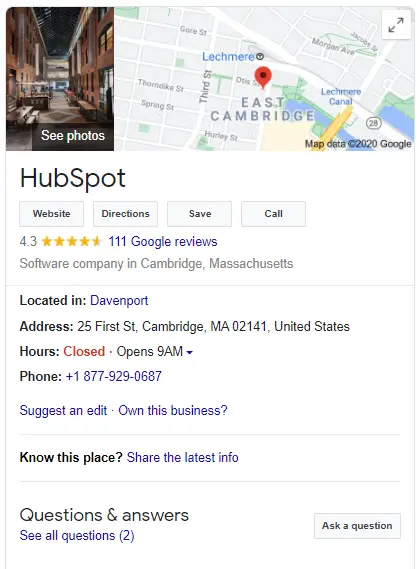
They can even see your customer reviews here.
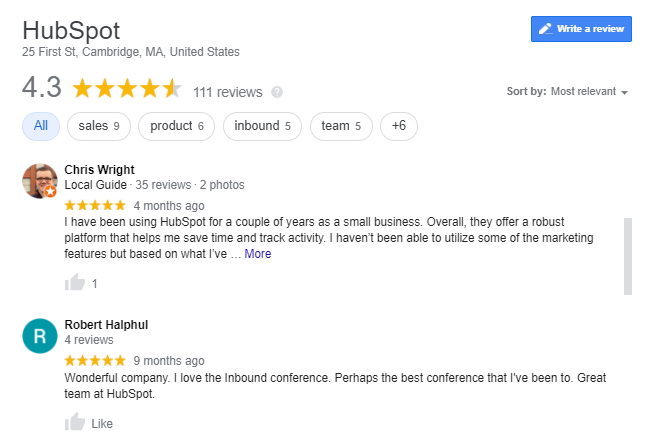
Now, if you were about to spend hundreds or thousands of dollars on online software… wouldn’t you want to investigate if the company you’re dealing with is legit first?
Anybody can put up a beautiful site on the internet and make BIG promises.
But not everybody can have a GMB profile with a permanent address that shows a physical office. Not everybody can rack up good reviews (Google is meticulous in deleting fake reviews).
Only legit businesses can.
That’s why a great GMB profile is a great way to build trust – even if no one will pay you a visit.
You can also use your GMB profile to show pictures of your office space. This will assure clients that you are capable of giving them excellent customer support.
As said before, SEO is only successful when thousands of tiny things come together to bring your site up.
One of the EASIEST ways software as a service companies can help their SEO strategy is through local SEO.
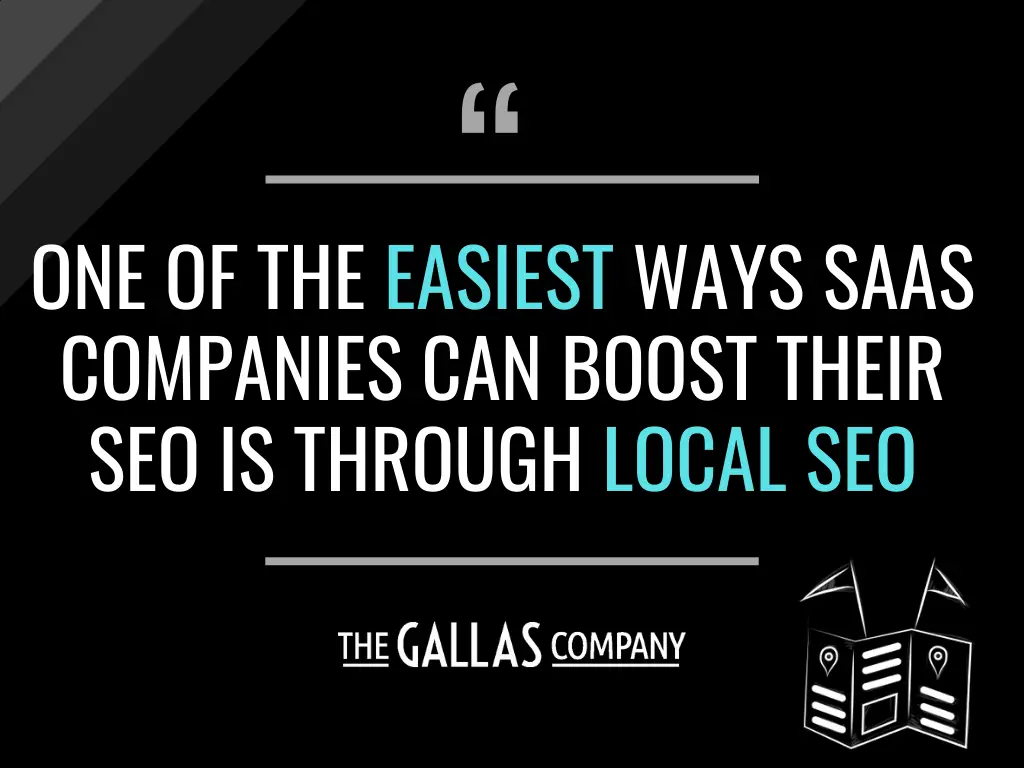
As a SaaS company, all you have to do are the local SEO basics. You don’t have to milk everything you can get from it as some other industries should.
That’s why anybody can do your local SEO.
You can even do it yourself if you have the time. Unlike national SEO, it requires zero expertise (although there are some tricks the professionals use to give it a boost).
No, local SEO won’t lift your site to the #1 spot overnight. But it’s a fast, easy, and cheap way to improve.
And in SEO, slow and steady always wins the race.
There is no science showing the relationship between GMB ranking and website ranking.
And most people treat them as two completely separate entities.
But it would be absurd to believe a strong GMB rank doesn’t affect your site rank.
Here’s why:
Google is always working to put the best and most relevant websites on top of search results.
They have hundreds of factors that play into their ranking system. It’s an incredibly complex algorithm that gets over 500 tweaks a year!
And nobody outside of Google – not even SEO experts like Brian Dean or Sam Oh – understands every factor in this algorithm.
That’s why even though there is no hard evidence that a good GMB rank helps your website’s position, it’s crazy to think it doesn’t.
Do you seriously believe that Google, with all its technology, won’t take a strong GMB profile into account when ranking a website?
Nobody has tested on this yet (because it would be an enormous headache), and Google hasn’t announced anything about it.
For now, though, you can be confident that improving your GMB profile will help your website rank.
Now let’s get practical.
Is local SEO worth your company’s time and money? Or should you focus your efforts and resources solely on national SEO?
You might be expecting a “Local SEO may be a small step, but it’s worth it.”
But no.
Honestly, for many SaaS companies, local SEO is a waste of time.
Weren’t we just discussing the benefits of local SEO?!?
Well, yes.
But you’ll have to determine whether the time and effort spent on local SEO is worth the benefits you’ll get.
How?
Ask yourself these questions first:
There’s no point in working on a local SEO strategy if you don’t have a permanent address.
A lot of SaaS companies aren’t based anywhere. The CEO might live in New York, while the developers might be all the way in Los Angeles.
There’s no official office or headquarters, which isn’t a particularly bad thing for SaaS companies.
Now, whether setting up a physical location is a good idea for your SaaS company or not is entirely up to you.
But from an SEO standpoint, it’s pointless to work on local SEO if you don’t have a permanent address.
However, if you do have a permanent address, than working on your local SEO will be helpful.
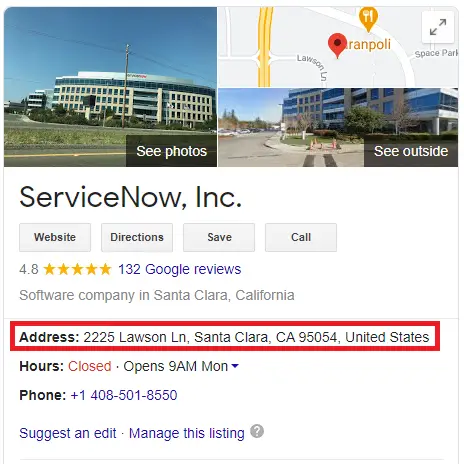
If you’re asking clients for hundreds, or even thousands, or dollars, you bet looking legit is vital.
People will want to know that you can’t just disappear with their money, that you have a permanent address where they can go if they have a major complaint.
But if all you’re charging for your SaaS is $10, most people won’t care. Your company can be scattered all over the world, and no one will try to find you.
Also, if you’re offering a SaaS that deals with sensitive documents (such as tax documents), people need to know they can trust you.
Whenever looking authentic is essential, a good GMB profile can win you new clients.
Local SEO should assist your SaaS’s national SEO strategy, NOT replace it.
If you can only do one thing, then, by all means, skip the local and go for the national SEO.
It’s a lot better to have a great content strategy on your SaaS website than to have an optimized GMB profile.
However, if you are already working on national SEO, it might be a good idea to spend some time on local SEO.
Again, SaaS companies only need the bare basics for local SEO. So it isn’t going to take much time.
But if you’re starting from scratch, ditch the local SEO for now.
Local SaaS SEO has a different goal than other brick and mortar businesses.
Instead of working tooth and nail to get into Google’s map pack – SaaS companies only need local SEO to put out a good GMB profile.
That’s why local SEO is super easy for SaaS.
How do you do it?
Let’s find out.
Sign up for Google My Business
Get Citations from Directory Sites
Ask for Customer Reviews
Head over to Google.com/business, click on “manage now,” fill up your details, and you’re done!
Once you verify your address, your Google My Business profile will be up and running.
Easy isn’t it?
But don’t stop there.
There is a difference between a GMB profile and a great GMB profile.
To optimize your profile, make sure you add as much information about your business as possible.
Fill out every blank space because the more information you give, the more Google (and potential clients!) trusts your business is legit.
You’ll also want to upload some pictures.
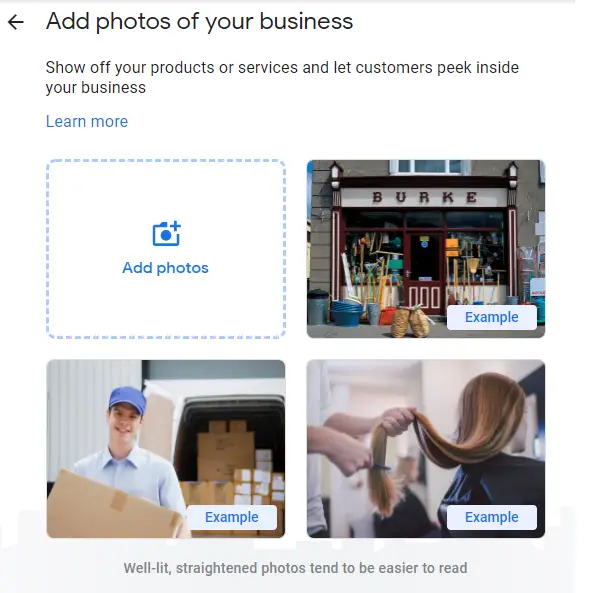
Nothing builds trust for online businesses more than showing pictures of your physical office. You can even throw in a picture of your staff for good measure.
Google will guide you on the pictures you should upload. Upload all of those, and it’s a good idea to throw in a few more as well.
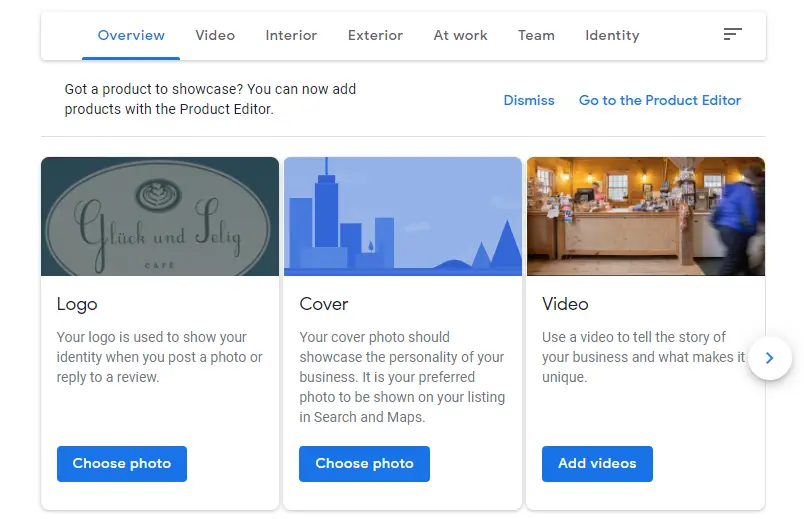
Remember, the people who will find your GMB profile are the ones typing your company’s name into the search bar.
These are the people looking for more information before doing business with you.
So give them that information. Give as much as you can to build trust with them.
A citation is anywhere on the internet where your business’s name, address, and telephone number (NAP) appears.
All citations will help boost your GMB profile’s rank on Google maps. That’s why brick and mortar stores chase after every single citation that they can possibly get.
However, it’s a bit different for SaaS companies.
Yes, getting your NAP out boosts your GMB rank (which may affect your website rank), but the real value SaaS companies get from citations are the links back to their site.
Some directory websites, such as Yelp and Bing, allow you to add your website link.

So visit these directory sites, and set up your business profile there.
Again, these aren’t as valuable as traditional links to your website. But the links from citations also help in their small way.
Note: make sure that your NAP is 100% consistent everywhere you put it. If not, it won’t count as a citation.
Here’s a frustrating fact:
Only a fraction of happy customers write reviews.
Unhappy customers?
Almost all of them will.
When this happens, it can paint a very bad picture of your business. People reading reviews on your GMB profile will get the impression that you do horrible business.
Now, you should work on your software and customer service to avoid getting bad reviews in the first place.
But sometimes, they just can’t be avoided.
So how do you avoid getting lopsided reviews?
Easy.
Ask for more good reviews.
Whenever you have happy customers, let them know that it’ll help you a LOT if they could leave a review.
GMB makes it easy for you to send your clients a review link, which you can find on your dashboard.
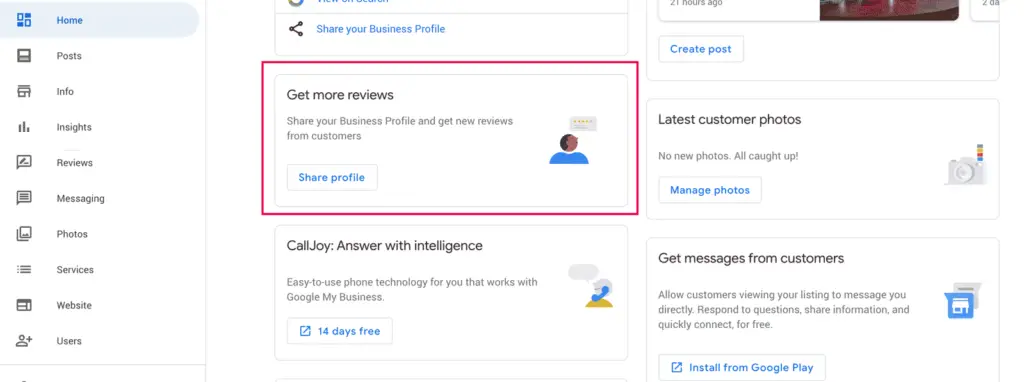
Don’t offer any incentive – that can get you in trouble with Google. Just ask your customers nicely. Shoot them a friendly email and make it easy for them.
You’ll be surprised how many want to help out.
And that is all you need to know about local SEO for SaaS companies.
No, it shouldn’t be the center of your SaaS SEO strategy.
But you shouldn’t ignore it either.
With everything you’ve learned today, you now have a solid idea of how much you should put into local SEO (or if you shouldn’t put anything into it at all).
So go on ahead and start building your local SEO!